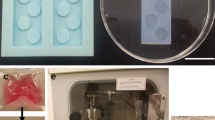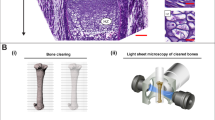Abstract
Spatial and temporal control of chondrogenesis generates precise, species-specific patterns of skeletal structures in the developing vertebrate limb. The pattern-template is laid down when mesenchymal cells at the core of the early limb bud condense and undergo chondrogenic differentiation. Although the mechanisms involved in organising such complex patterns are not fully understood, the interplay between BMP and Wnt signalling pathways is fundamental. Primary embryonic limb bud cells grown under high-density micromass culture conditions spontaneously create a simple cartilage nodule pattern, presenting a model to investigate pattern generation. We describe a novel analytical approach to quantify geometric properties and spatial relationships between chondrogenic condensations, utilizing the micromass model. We follow the emergence of pattern in live cultures with nodules forming at regular distances, growing and changing shape over time. Gene expression profiling supports rapid chondrogenesis and transition to hypertrophy, mimicking the process of endochondral ossification within the limb bud. Manipulating the signalling environment through addition of BMP or Wnt ligands, as well as the BMP pathway antagonist Noggin, altered the differentiation profile and nodule pattern. BMP2 addition increased chondrogenesis while WNT3A or Noggin had the opposite effect, but with distinct pattern outcomes. Titrating these pro- and anti-chondrogenic factors and examining the resulting patterns support the hypothesis that regularly spaced cartilage nodules formed by primary limb bud cells in micromass culture are influenced by the balance of Wnt and BMP signalling under a Turing-like mechanism. This study demonstrates an approach for investigating the mechanisms governing chondrogenic spatial organization using simple micromass culture.




Similar content being viewed by others
References
Ahrens PB, Solursh M, Reiter RS (1977) Stage-related capacity for limb chondrogenesis in cell culture. Dev Biol 60:69–82
Bhat R, Glimm T, Linde-Medina M, Cui C, Newman SA (2019) Synchronization of Hes1 oscillations coordinates and refines condensation formation and patterning of the avian limb skeleton. Mech Dev 156:41–54
Bobick BE, Alexander PG, Tuan RS (2014) High efficiency transfection of embryonic limb mesenchyme with plasmid DNA using square wave pulse electroporation and sucrose buffer. Biotechniques 56:85–89
Bobick BE, Chen FH, Le AM, Tuan RS (2009) Regulation of the chondrogenic phenotype in culture. Birth Defects Res C Embryo Today 87:351–371
Brady K, Dickinson SC, Guillot PV, Polak J, Blom AW, Kafienah W, Hollander AP (2014) Human fetal and adult bone marrow-derived mesenchymal stem cells use different signaling pathways for the initiation of chondrogenesis. Stem Cells Dev 23:541–554
Butterfield NC, Qian C, Logan MPO (2017) Pitx1 determines characteristic hindlimb morphologies in cartilage micromass culture. PLoS One 12, e0180453
Carlberg AL, Pucci B, Rallapalli R, Tuan RS, Hall DJ (2001) Efficient chondrogenic differentiation of mesenchymal cells in micromass culture by retroviral gene transfer of BMP-2. Differentiation 67:128–138
Christley S, Alber MS, Newman SA (2007) Patterns of mesenchymal condensation in a multiscale, discrete stochastic model. PLoS Comput Biol 3, e76
Cunze S, Kochmann J, Kuhn T, Frank R, Dorge DD, Klimpel S (2018) Spatial and temporal patterns of human Puumala virus (PUUV) infections in Germany. PeerJ 6, e4255
Day TF, Guo X, Garrett-Beal L, Yang Y (2005) Wnt/beta-catenin signaling in mesenchymal progenitors controls osteoblast and chondrocyte differentiation during vertebrate skeletogenesis. Dev Cell 8:739–750
Delgado I, Torres M (2016) Gradients, waves and timers, an overview of limb patterning models. Semin Cell Dev Biol 49:109–115
Duke PJ, Montufar-Solis D, Hamazaki T, Sato A (1998) Clinorotation reduces number, but not size, of cartilaginous nodules formed in micromass cultures of mouse limbbud cells. Adv Space Res (COSPAR) 21:1065–1072
Duprez D, Bell EJ, Richardson MK, Archer CW, Wolpert L, Brickell PM, Francis-West PH (1996) Overexpression of BMP-2 and BMP-4 alters the size and shape of developing skeletal elements in the chick limb. Mech Dev 57:145–157
Ferrer-Vaquer A, Piliszek A, Tian G, Aho RJ, Dufort D, Hadjantonakis AK (2010) A sensitive and bright single-cell resolution live imaging reporter of Wnt/ß-catenin signaling in the mouse. BMC Dev Biol 10:121
Francis-West PH, Abdelfattah A, Chen P, Allen C, Parish J, Ladher R, Allen S, MacPherson S, Luyten FP, Archer CW (1999) Mechanisms of GDF-5 action during skeletal development. Development 126:1305–1315
Glimm T, Bhat R, Newman SA (2020) Multiscale modeling of vertebrate limb development. Wiley Interdiscip Rev Syst Biol Med 12, e1485
Green JB, Sharpe J (2015) Positional information and reaction-diffusion: two big ideas in developmental biology combine. Development 142:1203–1211
Guo X, Day TF, Jiang X, Garrett-Beal L, Topol L, Yang Y (2004) Wnt/beta-catenin signaling is sufficient and necessary for synovial joint formation. Genes Dev 18:2404–2417
Hartmann C, Tabin CJ (2000) Dual roles of Wnt signaling during chondrogenesis in the chicken limb. Development 127:3141–3159
Hartmann C, Tabin CJ (2001) Wnt-14 plays a pivotal role in inducing synovial joint formation in the developing appendicular skeleton. Cell 104:341–351
Juhasz T, Matta C, Somogyi C, Katona E, Takacs R, Soha RF, Szabo IA, Cserhati C, Szody R, Karacsonyi Z, Bako E, Gergely P, Zakany R (2014) Mechanical loading stimulates chondrogenesis via the PKA/CREB-Sox9 and PP2A pathways in chicken micromass cultures. Cell Signal 26:468–482
Klumpers DD, Smit TH, Mooney DJ (2015) The effect of growth-mimicking continuous strain on the early stages of skeletal development in micromass culture. PLoS One 10, e0124948
Kondo S, Miura T (2010) Reaction-diffusion model as a framework for understanding biological pattern formation. Science 329:1616–1620
Krause C, Guzman A, Knaus P (2011) Noggin. Int J Biochem Cell Biol 43:478–481
Long F, Ornitz DM (2013) Development of the endochondral skeleton. Cold Spring Harb Perspect Biol 5, a008334
Marcon L, Diego X, Sharpe J, Müller P (2016) High-throughput mathematical analysis identifies Turing networks for patterning with equally diffusing signals. eLife 5
Maretto S, Cordenonsi M, Dupont S, Braghetta P, Broccoli V, Hassan AB, Volpin D, Bressan GM, Piccolo S (2003) Mapping Wnt/beta-catenin signaling during mouse development and in colorectal tumors. Proc Natl Acad Sci U S A 100:3299–3304
Mello MA, Tuan RS (1999) High density micromass cultures of embryonic limb bud mesenchymal cells: an in vitro model of endochondral skeletal development. In vitro cellular & developmental biology. Animal 35:262–269
Mello MA, Tuan RS (2006) Effects of TGF-beta1 and triiodothyronine on cartilage maturation: in vitro analysis using long-term high-density micromass cultures of chick embryonic limb mesenchymal cells. J Orthop Res 24:2095–2105
Mendes LF, Tam WL, Chai YC, Geris L, Luyten FP, Roberts SJ (2016) Combinatorial analysis of growth factors reveals the contribution of bone morphogenetic proteins to chondrogenic differentiation of human periosteal cells. Tissue Eng Part C Methods 22:473–486
Miao Q, Yuan YJ, Luo GM, Wei CH, Rao YQ, Gong YH, Zhang L, Shao J, Dong YK (2016) Study on ecological suitability of Gardenia jasminoides based on ArcGIS and Maxent model. Zhongguo Zhong yao za zhi = Zhongguo zhongyao zazhi = China journal of Chinese materia medica 41, 3181–3185
Miura T, Komori M, Shiota K (2000) A novel method for analysis of the periodicity of chondrogenic patterns in limb bud cell culture: correlation of in vitro pattern formation with theoretical models. Anat Embryol (berl) 201:419–428
Miura T, Shiota K (2000a) Extracellular matrix environment influences chondrogenic pattern formation in limb bud micromass culture: experimental verification of theoretical models. Anat Rec 258:100–107
Miura T, Shiota K (2000b) TGFbeta2 acts as an “activator” molecule in reaction-diffusion model and is involved in cell sorting phenomenon in mouse limb micromass culture. Dev Dyn 217:241–249
Newman GD, Smith AL, Brody SD (2017) Repurposing vacant land through landscape connectivity. Landsc J 36:37–57
Norrie JL, Lewandowski JP, Bouldin CM, Amarnath S, Li Q, Vokes MS, Ehrlich LIR, Harfe BD, Vokes SA (2014) Dynamics of BMP signaling in limb bud mesenchyme and polydactyly. Dev Biol 393:270–281
Nyakarahuka L, Ayebare S, Mosomtai G, Kankya C, Lutwama J, Mwiine FN, Skjerve E (2017) Ecological niche modeling for filoviruses: a risk map for Ebola and Marburg virus disease outbreaks in Uganda. PLoS currents 9
Olanrewaju OE, Adepoju KA (2017) Geospatial assessment of cholera in a rapidly urbanizing environment. J Environ Public Health 2017:6847376
Onodera K, Takahashi I, Sasano Y, Bae JW, Mitani H, Kagayama M, Mitani H (2005) Stepwise mechanical stretching inhibits chondrogenesis through cell-matrix adhesion mediated by integrins in embryonic rat limb-bud mesenchymal cells. Eur J Cell Biol 84:45–58
Raspopovic J, Marcon L, Russo L, Sharpe J (2014) Modeling digits. Digit patterning is controlled by a Bmp-Sox9-Wnt Turing network modulated by morphogen gradients. Science 345:566–570
Ray A, Singh PN, Sohaskey ML, Harland RM, Bandyopadhyay A (2015) Precise spatial restriction of BMP signaling is essential for articular cartilage differentiation. Development 142:1169–1179
Rolfe RA, Shea CA, Singh PNP, Bandyopadhyay A, Murphy P (2018) Investigating the mechanistic basis of biomechanical input controlling skeletal development: exploring the interplay with Wnt signalling at the joint. Philos Trans R Soc Lond B Biol Sci 373
Rudnicki JA, Brown AM (1997) Inhibition of chondrogenesis by Wnt gene expression in vivo and in vitro. Dev Biol 185:104–118
Saha A, Rolfe R, Carroll S, Kelly DJ, Murphy P (2017) Chondrogenesis of embryonic limb bud cells in micromass culture progresses rapidly to hypertrophy and is modulated by hydrostatic pressure. Cell Tissue Res 368:47–59
Seemann P, Schwappacher R, Kjaer KW, Krakow D, Lehmann K, Dawson K, Stricker S, Pohl J, Ploger F, Staub E, Nickel J, Sebald W, Knaus P, Mundlos S (2005) Activating and deactivating mutations in the receptor interaction site of GDF5 cause symphalangism or brachydactyly type A2. J Clin Invest 115:2373–2381
Singh PNP, Shea C, Sonker SK, Rolfe R, Ray A, Kumar S, Gupta P, Murphy P, Bandyopadhyay A (2018) Precise spatial restriction of BMP signaling in developing joints is perturbed upon loss of embryo movement. Development
Spater D, Hill TP, Gruber M, Hartmann C (2006) Role of canonical Wnt-signalling in joint formation. Eur Cell Mater 12:71–80
Summerhurst K, Stark M, Sharpe J, Davidson D, Murphy P (2008) 3D representation of Wnt and Frizzled gene expression patterns in the mouse embryo at embryonic day 11.5 (Ts19). Gene Expr Patterns 8:331–348
Takacs R, Matta C, Somogyi C, Juhasz T, Zakany R (2013) Comparative analysis of osteogenic/chondrogenic differentiation potential in primary limb bud-derived and C3H10T1/2 cell line-based mouse micromass cultures. Int J Mol Sci 14:16141–16167
Zimmerman LB, De Jesús-Escobar JM, Harland RM (1996) The Spemann organizer signal noggin binds and inactivates bone morphogenetic protein 4. Cell 86:599–606
Acknowledgements
Thanks to Dermot McMurrough, with the assistance from Jesko Zimmerman at Trinity College for writing the code to calculate proximity data nearest neighbour distances (NearestTable.py). Thanks to Prof Celia Holland for advice on statistical analysis.
Funding
This work was supported by Trinity College (R. R. and P. M.) and an Irish Research Council Postgraduate Studentship (C.S.).
Author information
Authors and Affiliations
Contributions
Conception and design: R. R., C. S. and P. M. Acquisition of data: R. R. and C. S. Analysis and interpretation: all the authors. Writing and revising the article: all the authors. Final approval for publication: all the authors.
Corresponding author
Ethics declarations
Ethical approval
Mice were housed and bred at the Comparative Medicine Unit under accreditation from the Health Products Regulatory Agency (HPRA), Ireland. All the animal work was carried out under personal licence from the HPRA. Procedures are approved by the Trinity College Research Ethics Committee where required (all the procedures here are covered by licence and no additional ethical approval was required).
Conflict of interest
The authors declare no competing interests.
Additional information
Publisher's Note
Springer Nature remains neutral with regard to jurisdictional claims in published maps and institutional affiliations.
Supplementary Information
Below is the link to the electronic supplementary material.
Rights and permissions
About this article
Cite this article
Rolfe, R.A., Shea, C.A. & Murphy, P. Geometric analysis of chondrogenic self-organisation of embryonic limb bud cells in micromass culture. Cell Tissue Res 388, 49–62 (2022). https://doi.org/10.1007/s00441-021-03564-y
Received:
Accepted:
Published:
Issue Date:
DOI: https://doi.org/10.1007/s00441-021-03564-y




